Belgian Shepherd Dog
Herding Dog Group
The goals and purposes of this breed standard include: to furnish guidelines for breeders who wish to maintain the quality of their breed and to improve it; to advance this breed to a state of similarity throughout the world; and to act as a guide for judges.
Breeders and judges have the responsibility to avoid any conditions or exaggerations that are detrimental to the health, welfare, essence and soundness of this breed, and must take the responsibility to see that these are not perpetuated.
Any departure from the following should be considered a fault, and the seriousness with which the fault should be regarded should be in exact proportion to its degree and its effect upon the health and welfare of the dog and on the dogs ability to perform its traditional work.
History
On September 29, 1891, the Club due Chien de Berger Belge (Belgian Shepherd Dog Club) was organized to determine the characteristics of the native shepherd dogs in Belgium. They defined a consistent type of native dog, anatomically identical but differing in hair texture, hair length and colors.
During the first decade of the twentieth century, owners and breeders in Belgium urged acceptance of additional Varieties based on color and the adoption of place names to designate those Varieties. The black, long-hairs were given the name Groenendael. The fawn, rough-hairs were given the name Laekenois. The short-haired fawn with black mask and charcoaling was given the name Malinois. The name Tervueren was given to the long-haired fawn with black mask and charcoaling. Tervueren later became the designation for the long-hair other than black.
His abilities as an intelligent and versatile working dog soon gained him popularity in other countries as well. The first Belgian Shepherd Dogs were imported into the United States in the early 1900's. Although earlier identified as three separate breeds, when UKC registered the Belgian Shepherd Dog in 1991, they were once again united as a single breed with four distinct varieties.
General Appearance
The Belgian Shepherd Dog is an elegant, well-proportioned, medium-sized, square dog. By his majestic carriage and harmony of form, the dog of the Belgian Sheepherders gives the impression of elegant robustness. He is a hardy individual, accustomed to living in the open air and built to resist inclement weather and the atmospheric changes so frequent in the Belgian climate. His elegance and expression denote great strength of character, making him a proud representative of the herding breeds.
Disqualifications: Unilateral or bilateral or cryptorchid.
Characteristics
The Belgian Shepherd Dog was developed in Belgium as a herding dog to work sheep. He is enthusiastic and remarkably quick. He shows a natural tendency to be in motion. The Belgian was developed for endurance. He must be able to move and tend the flock all day and to guard it from all invaders. In addition to his inborn ability as guardian of the flocks, he is an exceptional watchdog and a tenacious and brave defender of his master and family. He is vigilant, and highly responsive to his owner's direction. He is alert, intelligent and inquisitive. While he is firmly loyal to those he knows and loves, he typically exhibits reserve with strangers.
Disqualifications: Viciousness or extreme shyness.
Head
The head is finely chiseled, long without exaggeration, and lean. The skull and muzzle are approximately the same length with, at most, a very slight advantage for the muzzle; which gives the whole head a finished impression.
Fault: Too broad or too heavy a head; or a too pointed, foxy head.
SKULL
Medium width in proportion to the length of the head. The forehead is more flat than round. The occiput is not accentuated. Seen in profile, the upper line of the skull is parallel to an imaginary line drawn from the muzzle.
MUZZLE
Of approximately equal length to the length of the skull, narrowing gradually toward the nose. The upper line of the muzzle is straight; and seen in profile it is parallel to an imaginary line drawn from the skull. The mouth is well split. When the mouth is open, the corners are drawn well back and are in line with the eyes. The muzzle is well-chiseled under the eyes.
STOP
Moderate.
Fault: Excessive, or lack of, stop.
NOSE
Black, with well-opened nostrils.
Fault: Lack of external pigmentation.
LIPS
Thin in texture, well-tightened, strongly pigmented, not allowing the red of the mucous membranes to show when closed.
Fault: Lack of external pigmentation.
CHEEKS
Clean and flat, although very muscular.
EYES
Medium size, neither prominent nor deep set. Almond in shape, obliquely set, brown in color, preferably dark. Their look is direct, lively, intelligent and questioning. The eyelids are edged in black.
Fault: Very light or round eyes.
EARS
High set, triangular, carried well-pricked. The ears are small to medium and in proportion to the length of the head and the size of the dog. The concavity of the ear (concha) is well-curved at the base. The base of the ear does not come below an imaginary line drawn from the corner of the eye.
Disqualifications: Drooping or hanging ears.
DENTITION
Jaws are well-developed and furnished with forty-two strong, white teeth that meet in scissors bite. A level meeting of the incisors is acceptable. It is the so-called pincer bite which was preferred by the herdsmen.
Fault: Absence of premolar(s) or molar(s); the absence of one premolar (PMI) is not penalized.
Disqualifications: Undershot or overshot bite such that contact with two incisors is lost. (Note: loss of contact caused by short center incisors shall not be judged as undershot in an otherwise correct bite.)
Neck
The neck is distinct. The neck is slightly elongated and muscular, without throatiness, widening gradually towards the shoulders. The nape is very slightly arched.
Forequarters
The Belgian Shepherd Dog has a solid skeletal structure, lean with strong musculature.
SHOULDERS
The shoulder blades are long and sloping, securely and flatly attached, forming with the upper arm (humerus) an angle sufficient to insure the free movement of the elbows.
ARMS
The upper arms lie close to the body. They move in a direction parallel to the longitudinal (lengthwise) axis of the body. The dog single tracks as speed increases.
FOREARMS
Long and well-muscled.
PASTERNS
(Metacarpal bones) Short, strong and slightly sloping.
FORE FEET
Round. The toes are curved and quite compact. The pads are dense and elastic. The nails are dark and strong.
Body
The body is powerful without heaviness. The length, measured from the point of the shoulder to the end of the rump (ischium), is approximately equal to the height at the withers. In bitches, the length can go slightly beyond the height of the withers.
BREAST
Seen from the front, the breast is not too broad, without being narrow.
CHEST
Not too broad, but in compensation, deep and inclined. The thoracic cage is encircled by ribs which are arched in the upper part, but flat on the sides.
WITHERS
Accentuated.
BACK AND LOINS
The back and lumbar/loin region are straight, broad and powerfully muscled and short.
CROUP
Very slightly sloped. Broad without exaggeration.
ABDOMEN
Moderately developed, neither hanging (paunchy) nor tucked up. It prolongs, in a harmonious curve, the line under the chest.
Hindquarters
Powerful without heaviness. The legs are perpendicular to the ground, moving in the same plane as the forequarters. The dog single tracks as speed increases.
THIGHS
Broad and well-muscled.
STIFLE
Long, broad, well muscled and moderately angulated, without exaggeration.
HOCKS
The hocks should be short, broad and muscled. Seen from the rear, they will be perfectly parallel (to each other).
REAR PASTERNS
(Metatarsal Bones) Solid and short. Removal of rear dewclaws is preferred but not mandatory.
HIND FEET
Slightly oval, with the toes curved and very compact. Dense and elastic pads. The nails are black and strong.
TAIL
The tail is well set and of medium length, extending to the hocks. When at ease, the dog carries it at the level of the hock, with the tip slightly curved toward the rear. When in action, the dog raises it higher and accentuates the curve towards the tip, without at any time forming a hook or a deviation. (The tail is held without deviating from the center line.)
Fault: Tail carried too high, hooked or carried outside the median line.
Disqualifications: Absence of or docked tail.
Size
The desirable size for males is 23 inch - 26.5 inch.
The desirable size for females is 21 inch - 24.5 inch.
Eliminating Faults: Males under 23 inch or over 26.5 inch. Females under 21 inch or over 24.5 inch.
Gait
The gait is ground covering, effortless and seemingly tireless. The Belgian Shepherd Dog is usually in motion and is capable of working livestock all day. As speed increases, the breed single tracks.
Coat
The hair should be rich and dense, giving good protection against wet and cold. The undercoat is very dense, corresponding with climatic conditions. Since the length, direction and appearance of the hair is different in the dogs of the Belgian Shepherd Dog breed, this point was adopted as a criterion for distinguishing the breed's Varieties. In all the Varieties, the hair must always be abundant, dense and of good texture, forming with the wooly undercoat an excellent protective covering.
Long Hair
Groenendael and Tervueren: The hair is short on the head, the exterior face of the ears, and the lower part of the legs, except on the back of the forelegs, from the elbows to the pasterns, which are garnished by long hairs called feathering. The hair is long and straight over the rest of the body and longer and more abundant around the neck and on the breast, where it forms a collarette and frill. The opening of the ear is protected by tufted hairs. The hair from the base of the ear is raised back and frames the head. The thighs are covered with very long and abundant hair, which forms culottes. The tail is garnished with abundant hair, forming a plume.
Faults: Wavy hair. Lack of sufficient undercoat to form a double coat.
Short Hair
Malinois: The hair should be short on the head, the exterior of the ears and the lower parts of the legs. Short on the rest of the body, thicker on the tail and around the neck, where it forms a slight collarette beginning at the base of the ear and extending to the throat. In addition, the hindquarters should be fringed with longer hair. The coat should be thick, close and of good firm texture with a woolly undercoat. The coat should conform to the body without standing out or hanging down. The distribution of hair on the tail simulates an ear of wheat.
Fault: Lack of sufficient undercoat to form a double coat. Wavy hair. Too long hair.
Rough Hair
Laekenois: The hair is rough and of a harsh state, which further appears disorderly. The length of the hair is noticeably the same on all parts of the body. The length is approximately two and a half inches (six centimeters). The hair around the eyes and the hair garnishing the muzzle is not excessive. The existence of a hard, rough beard and moustache on the muzzle are mandatory. The tail does not form a plume.
Faults: Silky or soft hair. Lack of sufficient undercoat to form a double coat.
Colors
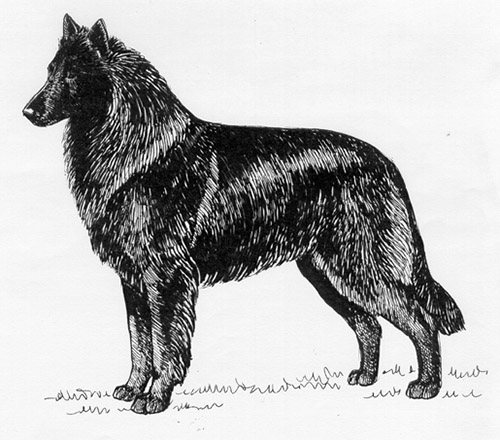
Groenendael
The Groenendael is the long-haired black. The Groenendael may be all black, or may be black with a small to moderate white patch on the chest, and the tips of the toes may be white. White or gray frosting on the muzzle is acceptable.
Fault: Dominant red tinge.
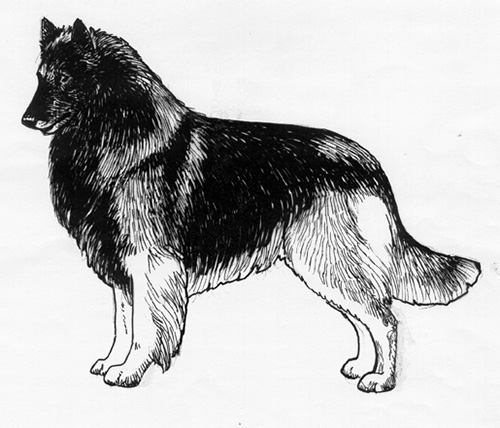
Tervueren
The Tervueren is the charcoaled, long-haired, other than black with dark mask. A small to moderate white patch is permitted on the chest, and the tips of the toes may be white. White or gray frosting on the muzzle is acceptable.
Body Fawn and Sable: All the gamut of colors through beige to gray, with charcoaling. The coat is characteristically double pigmented, wherein the tip of each hair is blackened. On mature males, this darkening is especially pronounced on the shoulders, back and rib section. The under parts of the body, tail and coulottes are cream, gray or light beige. The coat characteristically becomes darker with increasing age. Allowance should be made for females and young males. The tail typically has a darker tip.
Faults: Lack of charcoaling at maturity. Excessive charcoaling, tending to a black saddle, black in patches.
Face: The face has a black mask. The preferred mask is well pronounced, stretching to unite the upper and lower lips, the corners of the mouth, and the eyelids, in a single dark zone. The ears are mostly dark. An open mask or mostly black head is acceptable.
Faults: Minimal mask.
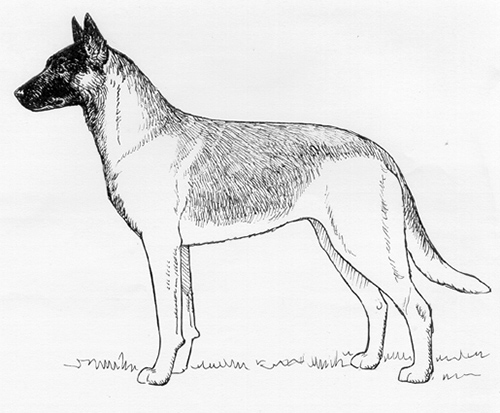
Malinois
The Malinois is the short-haired, charcoal, other than black, with a dark mask. The small to moderate white patch is permitted on the chest, and the tips of the toes may be white. White or gray frosting on the muzzle is acceptable.
Body: Fawn and Sable (all the gamut of colors through beige to gray), with charcoaling. The coat is characteristically double pigmented, wherein the tip of each hair is blackened. On mature males this darkening is especially pronounced on the shoulders, back and rib section. The under parts of the body, tail and coulottes are cream gray or light beige. The coat characteristically becomes darker with increasing age. Allowance should be made for female and young males. The tail typically has darker tip.
Faults: Lack of charcoaling at maturity. Excessive charcoaling tending to a black saddle, black in patches.
Face: The face has a black mask. The preferred mask is well pronounced, stretching to unite the upper and lower lips, the corners of the mouth, and the eyelids in a single dark zone. The ears are mostly dark. An open mask or mostly black head is acceptable.
Faults: Minimal mask.
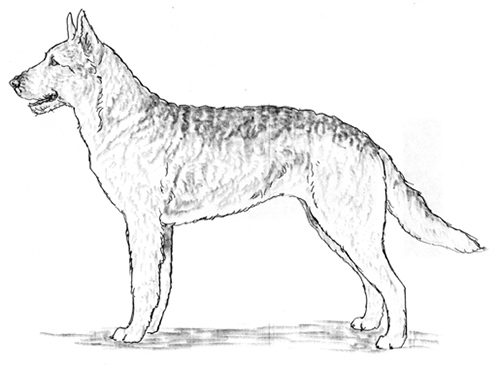
Laekenois
The Laekenois is the rough haired other than black, with traces of charcoaling, principally on the muzzle and tail. A small to moderate white patch is permitted on the chest, and the tips of the toes may be white. White or gray frosting on the muzzle is acceptable.
Body: Fawn and Sable (all the gamut of colors through beige to gray), with charcoaling. The coat is characteristically double pigmented, wherein the tip of each hair is blackened. On mature males, this blackening is especially pronounced on the shoulders, back and rib section. The under parts of the body, tail and coulottes are cream, gray or light beige. The coat characteristically becomes darker with increasing age. Allowance should be made for females and young males. The tail typically has a darker tip.
Disqualifications: All varieties. Albinism. Solid white markings elsewhere than on tips of toes, chest, or frosting on muzzle. In Tervueren and Malinois, the absence of black on one or more of the following points: ear bases, eyebrows, sides of muzzle and underjaw.
Faults
Bitch type of dog; dog type of bitch.
The Belgian Shepherd Dog is a herding dog, and faults that affect his ability to work livestock in all types of climatic changes should be particularly penalized.
Eliminating Faults
(An Eliminating Fault is a Fault serious enough that it eliminates the dog from obtaining any awards in a conformation event.)
Males under 23" or over 26.5". Females under 21" or over 24.5".
Disqualifications
(A dog with a Disqualification must not be considered for placement in a conformation event, and must be reported to UKC.)
Unilateral or bilateral or cryptorchid.
Viciousness or extreme shyness.
Albinism.
Undershot or overshot bite such that contact with two incisors is lost. (Note: loss of contact caused by short center incisors shall not be judged as undershot in an otherwise correct bite.)
Drooping or hanging ears.
Solid white markings elsewhere than on tips of toes, chest, or frosting on muzzle.
Absence of or docked tail.
In Tervueren and Malinois, the absence of black on one or more of the following points: ear bases, eyebrows, sides of muzzle and underjaw.
Please Note
In UKC Conformation Shows, this breed is shown by variety in this order: Groenendael, Laekenois, Malinois, Tervueren.
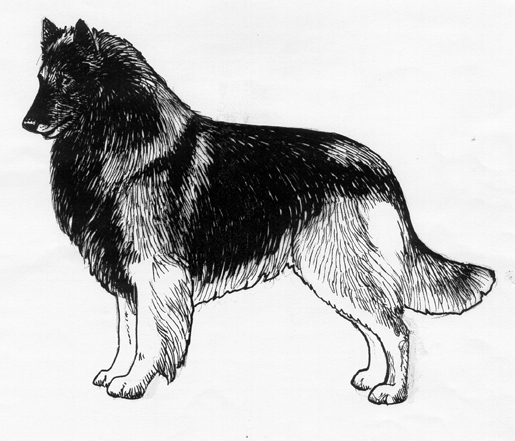
More Info
For more information on this breed, please visit the United Belgian Shepherd Dog Association
Looking for a Dog?
Find a dog that will fit your family.
Note: The breeders on this list are not endorsed by UKC.
Revised January 2, 2024
©Copyright 1991, United Kennel Club
